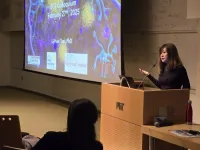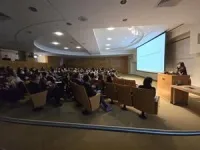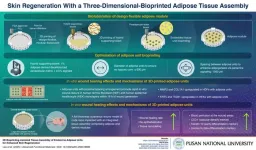(Press-News.org) A decade after scientists in The Picower Institute for Learning and Memory at MIT first began testing whether sensory stimulation of the brain’s 40Hz “gamma” frequency rhythms could treat Alzheimer’s disease in mice, a growing evidence base supporting the idea that it can improve brain health—in humans as well as animals—has emerged from the work of labs all over the world. A new review article in PLOS Biology describes the state of research so far and presents some of the fundamental and clinical questions at the forefront of the non-invasive gamma stimulation now.
“As we’ve made all our observations, many other people in the field have published results that are very consistent,” said Li-Huei Tsai, Picower Professor at MIT, director of MIT’s Aging Brain Initiative, and senior author of the new review with postdoc Jung Park. “People have used many different ways to induce gamma including sensory stimulation, transcranial alternating current stimulation or transcranial magnetic stimulation, but the key is delivering stimulation at 40 Hz. They all see beneficial effects.”
A decade of discovery at MIT
Starting with a paper in Nature in 2016, a collaboration led by Tsai has produced a series of studies showing that 40Hz stimulation via light, sound, the two combined, or tactile vibration reduces hallmarks of Alzheimer’s pathology such as amyloid and tau proteins, prevents neuron death, decreases synapse loss, and sustains memory and cognition in various Alzheimer’s mouse models. The collaboration’s investigations of the underlying mechanisms that produce these benefits has so far identified specific cellular and molecular responses in many brain cell types including neurons, microglia, astrocytes, oligodendrocytes and the brain’s blood vessels. Last year, for instance, the lab reported in Nature that 40Hz audio and visual stimulation induced interneurons in mice to increase release of the peptide VIP, prompting increased clearance of amyloid from brain tissue via the brain’s glymphatic “plumbing” system.
Meanwhile, at MIT and at the MIT spinoff company Cognito Therapeutics, phase II clinical studies have shown that people with Alzheimer’s exposed to 40Hz light and sound experienced a significant slowing of brain atrophy and improvements on some cognitive measures compared to untreated controls. Cognito, which has also measured significant preservation of the brain’s “white matter” in volunteers, has been conducting a pivotal, nationwide phase III clinical trial of sensory gamma stimulation for more than a year.
“Neuroscientists often lament that it is a great time to have AD if you are a mouse,” Park and Tsai wrote in the review. “Our ultimate goal, therefore, is to translate GENUS discoveries into a safe, accessible, and non-invasive therapy for AD patients.” The MIT team often refers to 40Hz stimulation as “GENUS” for Gamma Entrainment Using Sensory Stimulation.
A growing field
As Tsai’s collaboration, which includes MIT colleagues Edward Boyden and Emery N. Brown, has published its results, many other labs have produced studies adding to the evidence that various methods of non-invasive gamma sensory stimulation can combat Alzheimer’s pathology. Among many examples cited in the new review, in 2024 a research team in China independently corroborated that 40Hz sensory stimulation increases glymphatic fluid flows in mice. In another example, a Harvard Medical School-based team in 2022 showed that 40Hz gamma stimulation using Transcranial Alternating Current Stimulation significantly reduced the burden of tau in three out of four human volunteers. And in another study involving more than 100 people, researchers in Scotland in 2023 used audio and visual gamma stimulation (at 37.5 Hz) to improve memory recall.
Open questions
Amid the growing number of publications describing preclinical studies with mice and clinical trials with people, open questions remain, Tsai and Park acknowledge. The MIT team and others are still exploring the cellular and molecular mechanisms that underlie GENUS’s effects. Tsai said her lab is looking at other neuropeptide and neuromodulatory systems to better understand the cascade of events linking sensory stimulation to the observed cellular responses. Meanwhile the nature of how some cells, such as microglia, respond to gamma stimulation and how that affects pathology remains unclear, Tsai added.
Even with a national Phase III clinical trial underway, it is still important to investigate these fundamental mechanisms, Tsai said, because new insights into how non-invasive gamma stimulation affects the brain could improve and expand its therapeutic potential.
“The more we understand the mechanisms, the more we will have good ideas about how to further optimize the treatment,” Tsai said. “And the more we understand its action and the circuits it affects, the more we will know beyond Alzheimer’s disease what other neurological disorders will benefit from this.”
Indeed the review points to studies at MIT and other institutions providing at least some evidence that GENUS might be able to help with Parkinson’s disease, stroke, anxiety, epilepsy, and the cognitive side effects of chemotherapy and conditions that reduce myelin such as multiple sclerosis. Tsai’s lab has been studying whether it can help with Down syndrome as well.
The open questions may help define the next decade of GENUS research.
END
Evidence expanding that 40Hz gamma stimulation promotes brain health
A decade of studies from labs around the world provide a growing evidence base that increasing the power of the brain’s gamma rhythms could help fight Alzheimer’s, and perhaps other, neurological diseases.
2025-03-03
ELSE PRESS RELEASES FROM THIS DATE:
Teaching kids how to become better citizens
2025-03-03
COLUMBUS, Ohio – In our polarized society, a new study offers hope for the future: Even young children can learn to discuss and argue about meaningful problems in a respectful and productive way.
Researchers at The Ohio State University found success in a social studies curriculum for fourth graders based on teaching what they called “civic competencies.”
Over the course of a school year, findings showed that the students participating in the curriculum significantly improved their argumentation skills and disciplinary thinking.
“This will give them the ability to collaborate, communicate effectively and consider multiple perspectives”, ...
Pusan National University researchers develop a novel 3D adipose tissue bioprinting method
2025-03-03
The adipose tissue, which serves as an endocrine organ, releases various molecules that regulate the repair of other damaged tissues, including the skin. Hence, adipose tissues can potentially be reengineered to regenerate the damaged organs. Three-dimensional (3D) bioprinting technology has revolutionized regenerative medicine by enabling the generation of engineered and functional 3D organs or tissues, including adipose tissues. However, the currently used tissue biofabrication methods cannot replicate ...
Scientists use AI to better understand nanoparticles
2025-03-03
A team of scientists has developed a method to illuminate the dynamic behavior of nanoparticles, which are foundational components in the creation of pharmaceuticals, electronics, and industrial and energy-conversion materials. The advance, reported in the journal Science, combines artificial intelligence with electron microscopy to render visuals of how these tiny bits of matter respond to stimuli.
“Nanoparticle-based catalytic systems have a tremendous impact on society,” explains Carlos Fernandez-Granda, director of NYU’s Center for Data Science and a professor of mathematics and data science, one of the paper’s authors. “It is estimated that 90 percent ...
We feed gut microbes sugar, they make a compound we need
2025-03-03
Gut microbes that were thought to feed exclusively on dietary fiber also get fed sugar from our guts, from which they produce short-chain fatty acids that are crucial to many body functions. The Kobe University discovery of this symbiotic relationship also points the way to developing novel therapeutics.
Gut microbes produce many substances that our body needs but cannot produce itself. Among them are short-chain fatty acids that are the primary energy source for the cells lining our guts but have other important roles, too, and ...
One of the largest psychotherapy trials in the world has implications for transforming mental health care during pregnancy and after birth
2025-03-03
Approximately one in five of pregnant and postpartum individuals experience depression and anxiety, yet less than 10 per cent receive proper treatment.
To address this problem, a team of interdisciplinary researchers from Canada and the United States investigated if talk therapy can be effectively delivered by non-mental health specialists and telemedicine to increase access. In a paper published today in Nature Medicine, they share results from the Scaling Up Maternal Mental health care by Increasing access to Treatment (SUMMIT) Trial, which reveals promising strategies to provide the necessary support and treatment more effectively and inclusively ...
It’s not just what you say – it’s also how you say it
2025-03-03
EVANSTON, Ill. --- You’ve probably heard the phrase, “It’s not what you say, it’s how you say it,” and now, science backs it up. A first-of-its-kind study from Northwestern University’s School of Communication, the University of Pittsburgh and the University of Wisconsin-Madison reveals a region of the brain, long known for early auditory processing, plays a far greater role in interpreting speech than previously understood.
The multidisciplinary study being published Monday, March ...
Sleep patterns may reveal comatose patients with hidden consciousness
2025-03-03
NEW YORK, NY (March 3, 2025)--Several studies in the past decade have revealed that up to a quarter of unresponsive patients with recent brain injuries may possess a degree of consciousness that’s normally hidden from their families and physicians.
New research from Columbia University and NewYork-Presbyterian may soon help physicians identify unresponsive brain-injury patients with hidden consciousness who are likely to achieve long-term recovery by looking for brain waves that are indicative of normal sleep patterns.
“We’re at an exciting crossroad in neurocritical care where we know that many patients appear to be unconscious, but some are recovering without ...
3D genome structure guides sperm development
2025-03-03
Two new landmark studies show how a seeming tangle of DNA is actually organized into a structure that coordinates thousands of genes to form a sperm cell. The work, published March 3 as two papers in Nature Structural and Molecular Biology, could improve treatment for fertility problems and developmental disorders.
“We are finding the 3D structure of the genome,” said Satoshi Namekawa, professor of microbiology and molecular genetics at the University of California, Davis and senior author on one of the papers. “This is really showing us how the genomic architecture guides development.”
Although DNA is a long, stringy molecule, in living ...
Certain genetic alterations may contribute to the primary resistance of colorectal and pancreatic cancers to KRAS G12C inhibitors
2025-03-03
Bottom Line: Colorectal cancer and pancreatic ductal adenocarcinoma that harbored the KRAS G12C mutation often carried other genetic alterations that can be associated with resistance to KRAS G12C inhibitors, despite no prior treatment with this therapy, according to recent results from a large multidatabase analysis.
Journal in Which the Study was Published: Clinical Cancer Research, a journal of the American Association for Cancer Research (AACR)
Author: Hao Xie, MD, PhD, a medical oncologist at Mayo Clinic Comprehensive Cancer Center
Background: “The KRAS pathway plays a crucial role in cell biology by regulating ...
Melting Antarctic ice sheets will slow Earth’s strongest ocean current
2025-03-03
Melting ice sheets are slowing the Antarctic Circumpolar Current (ACC), the world’s strongest ocean current, researchers have found.
This melting has implications for global climate indicators, including sea level rise, ocean warming and viability of marine ecosystems.
The researchers, from the University of Melbourne and NORCE Norway Research Centre, have shown the current slowing by around 20 per cent by 2050 in a high carbon emissions scenario.
This influx of fresh water into the Southern Ocean is expected to change ...
LAST 30 PRESS RELEASES:
What causes some people’s gut microbes to produce high alcohol levels?
Global study reveals widespread burning of plastic for heating and cooking
MIT study shows pills that communicate from the stomach could improve medication adherence
Searching for the centromere: diversity in pathways key for cell division
Behind nature’s blueprints
Researchers search for why some people’s gut microbes produce high alcohol levels
Researchers find promising new way to boost the immune response to cancer
Coffee as a staining agent substitute in electron microscopy
Revealing the diversity of olfactory receptors in hagfish and its implications for early vertebrate evolution
Development of an ultrasonic sensor capable of cuffless, non-invasive blood pressure measurement
Longer treatment with medications for opioid use disorder is associated with greater probability of survival
Strategy over morality can help conservation campaigns reduce ivory demand, research shows
Rising temperatures reshape microbial carbon cycling during animal carcass decomposition in water
Achieving ultra-low-power explosive jumps via locust bio-hybrid muscle actuators
Plant-derived phenolic acids revive the power of tetracycline against drug-resistant bacteria
Cooperation: A costly affair in bacterial social behaviour?
Viruses in wastewater: Silent drivers of pollution removal and antibiotic resistance
Sub-iethal water disinfection may accelerate the spread of antibiotic resistance
Three in four new Australian moms struggle with body image
Post-stroke injection protects the brain in preclinical study
Cardiovascular risk score predicts multiple eye diseases
Health: estimated one in ten British adults used or interested in GLP-1 medications for weight loss
Exercise to treat depression yields similar results to therapy
Whooping cough vaccination for pregnant women strengthens babies’ immune system
Dramatic decline in new cases of orphanhood in Uganda driven by HIV treatment and prevention programs
Stopping weight loss drugs linked to weight regain and reversal of heart health markers
Higher intake of food preservatives linked to increased cancer risk
Mass General Brigham–developed cholera vaccine completes phase 1 trial
First experimental validation of a “150-year-old chemical common sense” direct visualization of the molecular structural changes in the ultrafast anthracene [4+4] photocycloaddition reaction
Lack of support for people on weight loss drugs leaves them vulnerable to nutritional deficiencies, say experts
[Press-News.org] Evidence expanding that 40Hz gamma stimulation promotes brain healthA decade of studies from labs around the world provide a growing evidence base that increasing the power of the brain’s gamma rhythms could help fight Alzheimer’s, and perhaps other, neurological diseases.




